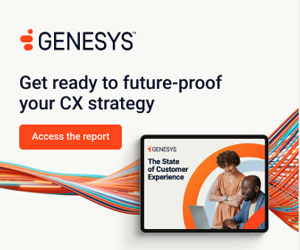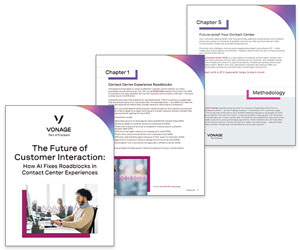Our panel of experts look at how speech analytics technology is expected to change over the next few years.
What can we expect in the next few years?
Whole phrases will be understood within conversations
Speech analytics is evolving all the time. Previously, most solutions relied on so-called ‘speech-to-text’ or phonetic conversion engines, which are not accurate enough for successful determination of phrases. This can mean lots of false positives, leading to huge frustration on the part of customers.
We are now moving towards more sophisticated speech recognition solutions, where whole phrases are understood within conversations. Every conversation is accurately and comprehensively analysed for customers, automatically detecting key phrases from which to take automated actions. Clearly this leads to much better customer experience.
Voice “fingerprints” will enable customers to reset their own passwords

Lucille Needham
We are also seeing very advanced technology like voice biometrics being introduced. Voice biometrics uses each customer’s voice as their spoken identifier, measuring characteristics such as pitch and rhythm to create a “fingerprint” unique to that voice.
Using a sensor, voice data is collected and converted into a digital file, which is then stored. Voice biometrics can be used for self-service password resetting, digitally voice-signing electronic documents, gaining access to secure systems, providing secure access to remote systems and verifying that a customer is at their claimed location.
With thanks to Lucille Needham at Genesys
Analytics applications will combine into one interactive user interface
Call centres are becoming more and more focused on communicating with their customers on multiple channels, and this has given birth to many different types of analytics. Text analytics for chat, social and web, speech analytics for the largest channel, the telephone. In the coming months, the most progressive of these analytics applications and tools are going to begin combining the analysis of the various channels into one interactive user interface.
Contact centres will be able to analyse the entire customer journey
Not only does this mean that you can reduce the complexity and stove piping traditionally associated with multichannel, but you will start to see a rise in the ability to watch a single customer’s “journey” across those various channels, and analyse characteristics and trends of journeys, not just individual interactions.

Jeff Gallino
Customer Journey Analysis will be transformational to enterprises that touch their customers across many channels and need to better understand how they can maximise that analysis and ultimately that journey.
From a customer’s point of view, when they have a question or a problem, they don’t think of their webchat, tweet, and phone call as “multichannel”, they think of it as “an attempt to solve my problem, I just used different approaches.”
With customer journey analytics, enterprises can finally view the journey the same way that the customer does: as a single set of interactions leading to an outcome. Analytics will enable organisations to optimise for positive outcomes in the most efficient manner.
With thanks to Jeff Gallino at CallMiner
It will be commonplace for speech analytics to work in real time
All customers want to deal with competent, high-quality staff with access to relevant information that enables them to solve their problems quickly and efficiently. Speech analytics is increasingly used to support this capability by recognising and understanding key phrases used in interactions and triggering searches of knowledge management systems, or FAQ sets, to supplement the work of human operators. Approaches like this which add real-time value to interactions in the contact centre are likely to become more prevalent over time.
Speech analytics will integrate with back-end systems
In the past, speech analytics solutions have often stood alone in the contact centre. Going forward, we will see greater integration of these solutions with back-end systems, leading to more automated evaluation of the information derived from speech analytics as the data within the system becomes a standard part of the quality management suite.
There is a growing understanding among businesses that to deliver optimum value, speech analytics should not be deployed in isolation but rather as part of a coordinated quality management strategy.

Nigel Olding
Qualitative analysis of the kinds of phrases used in written feedback
We are witnessing a shift in today’s speech analytics solutions away from simple word recognition to a more sophisticated phrase recognition capability.
This potentially enables businesses to migrate from pure quantitative number-based feedback (marks out of five awarded to hotels on holiday advice website) to a qualitative analysis of the kinds of phrases used in written feedback (customer service was poor and the staff rude and unhelpful).
This kind of phrase-based recognition will increasingly allow businesses to run speech analytics to achieve a more granular and intelligent awareness of customer satisfaction.
With thanks to Nigel Olding at Enghouse Interactive
Analytics tools will stop being used in silos
Speech analytics can tell us what we are discussing in our calls and what people are saying about us in our telephone surveys. Text analytics can tell us what we are discussing in our emails, webchats and correspondence, what our customers are saying about us on social media and what we are recording about our customers on their accounts.

Chris Rainsforth
Our telephone systems can tell us the time the customer had to wait, the route they took through the IVR and if they were passed between departments. Our CRM systems give us a host of transactional data and we have records of correspondence and marketing sent to our customer. Most of us also get our customers to complete CSAT or NPS surveys.
For our customers this all forms part of one experience, but only a small part of the overall picture visible.
We need to link this information together with the customer at the heart of everything.
That way we will see the unnecessary steps, processes and delays that frustrate our customers and cost us time and money, and understand the impact of our decisions on every step of our customers’ journey.
With thanks to Chris Rainsforth at The Forum
Speech analytics will offer ‘in the moment’ feedback

Ian Robertson
With recent breakthroughs in live mining we will start to see speech analytics providing ‘in the moment’ feedback and recommendations, based not only on the customer’s previous history, but also on what is being said on the call or done on the account.
We will see advisors reminded of any actions they have forgotten to take either to be compliant or provide the best possible service. This will allow companies to focus less of their resources on monitoring and addressing compliance issues and more on improving the end-to-end customer experience.
With thanks to Ian Robertson at The Forum
The cloud will enable speech analytics to become a routine function
Until now, speech analytics has been seen as a specialist function within contact centres. In the coming years there will be move away from this specialisation to see it more routinely used for gathering valuable customer feedback, as well as measuring the effectiveness of individual agents in organisations of all sizes.
This switch in emphasis will be enabled by the latest cloud-based multichannel contact centres, where integration with speech analytics is made easier by one-time integration in the cloud.
Embedding speech analytics into the contact centre enables organisations to analyse and search 100% of recorded customer calls in real time, helping to glean valuable intelligence from thousands – even millions – of customer calls quickly and efficiently.

Klaas van der Leest
It will become more accessible and affordable to all sizes of businesses
Recent advancements in speech analytics, along with the growing popularity of cloud-based contact centre solutions, will make speech analytics more affordable, and therefore accessible, to all sizes of businesses.
This is a far cry from just a few years ago, when only very large organisations with the financial clout and human resources to match had any hope of making meaningful customer analytics a reality.
With thanks to Klaas van der Leest at Intelecom UK
What can we expect in 5-10 years?

Enterprises will be able to share intra-journey customer information
In the future, if a customer goes to Amazon to order a new food replicator, their journey with Amazon will include the website and maybe, if they have a questions, a chat or call. But the customer will also have to pay for this purchase, typically using a bank credit card – and the package will be delivered (maybe by FedEx). In total, the customer’s perspective of this “single journey” includes 3 different enterprises.
Ecosystem analytics will allow enterprises to share intra-journey customer information (maybe tokenised for customer anonymity) to create an inter-journey view.
This will allow all of the fulfilling enterprises from our example to have a better understanding of their part in that single customer journey and allow them to cooperatively offer a better, more coherent, customer experience.
With thanks to Jeff Gallino at CallMiner
Robots will be able to provide answers to complex queries
With the power of artificial intelligence continuing to become ever more sophisticated, the ability for robot agents in the contact centre to be used to analyse voice patterns, assess emotional states and find solutions to even the most complex queries without requiring escalation to a human agent will increase significantly.
It will enhance the business beyond the contact centre
In the medium to long term, we believe the metrics captured by speech analytics will increasingly be extracted and made available to other business systems.
This will allow the value captured from speech-based analytics to be used to enhance the delivery of other functions beyond the contact centre.
Analytics will help capture the digital footprint of a customer
In the future, speech analytics will increasingly be used to capture the digital DNA or the digital footprint of customers. One of the key applications will be for authentication. Voice biometrics systems will make use of analytics techniques to establish the identity of individuals.
This will have particular advantages in sectors like legal and financial, where the interactions and information exchanged are sensitive. Customers will benefit too from an approach that delivers faster and easier authentication and authorisation than traditional PINs and passwords.
With thanks to Nigel Olding at Enghouse Interactive
What do you think the future holds for speech analytics? Do you agree with the ideas our panel have put forward?
Author: Megan Jones
Published On: 16th Sep 2015 - Last modified: 15th Jul 2025
Read more about - Technology, CallMiner, Chris Rainsforth, Enghouse Interactive, Genesys, Predictions, Puzzel, Speech Analytics, The Forum





















